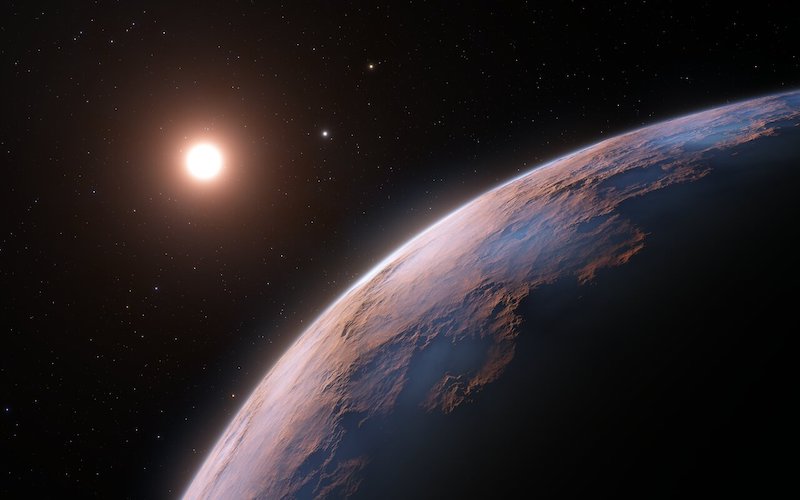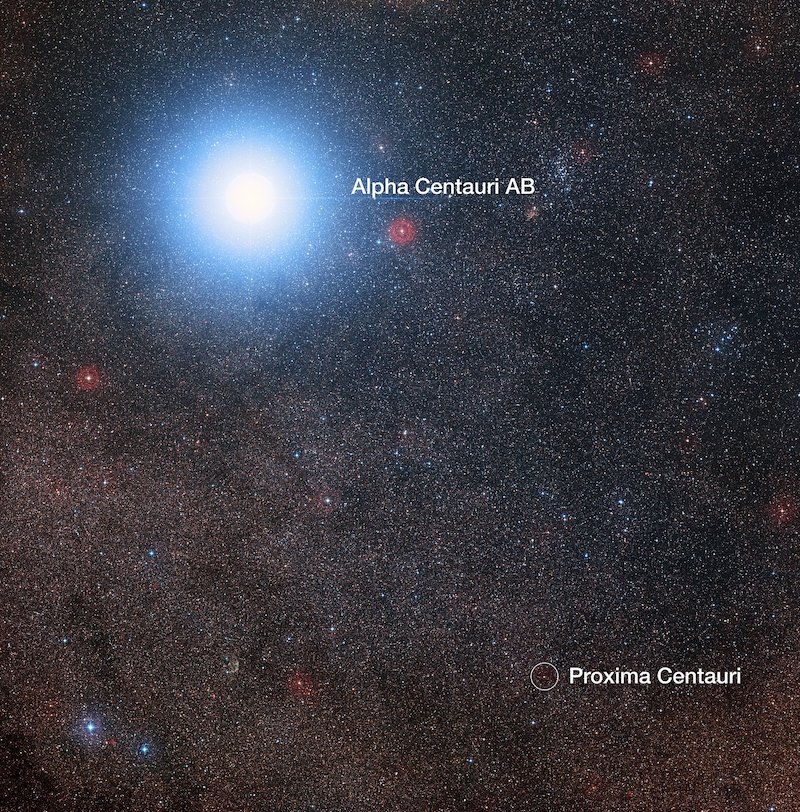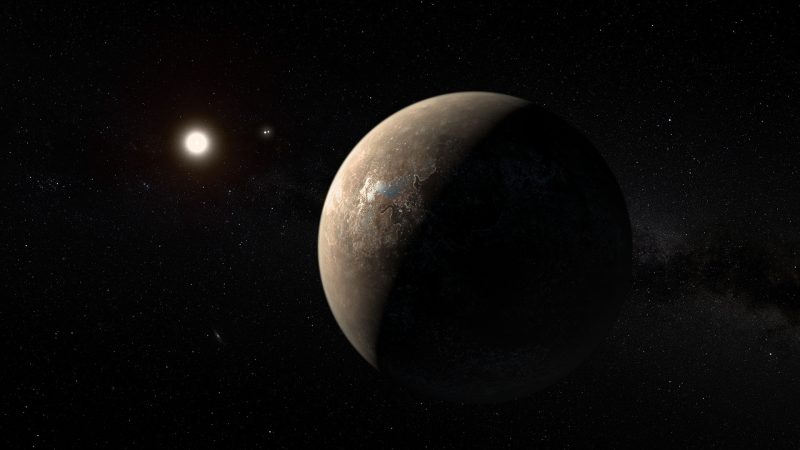
If we hope to someday make contact with life around another star, there’s no better place to look than at worlds around Proxima Centauri, the nearest star to our sun. Astronomers had already detected two exoplanets – worlds orbiting other stars – orbiting our closest stellar neighbor, which is only 4.2 light-years away. On February 10, 2022, researchers using the European Southern Observatory’s Very Large Telescope (VLT) said they found a third planet next door. The planet, Proxima d, is only 1/4 the mass of Earth and one of the smallest and lightest exoplanets discovered so far. The Proxima neighborhood is getting a little crowded!
The researchers published their peer-reviewed findings in the journal Astronomy & Astrophysics on February 10, 2022.
Meet the 3rd possible planet orbiting nearest star
The astronomers call the new world Proxima d. This follows the discovery of the two previous planets, Proxima b and Proxima c in 2016 and 2020, respectively. Proxima d is one of the lightest exoplanets found to date, at only about 1/4 of Earth’s mass.
The newly found planet orbits close to its star, at a distance of approximately 4 million kilometers (2.5 million miles). That’s more than 10 times closer to its star than Mercury orbits our own sun. It completes one orbit in only five days. Proxima d orbits closer to its star than the inner edge of the habitable zone around the star. The habitable zone is the region where liquid water could exist on a rocky planet.
Since Proxima Centauri is a red dwarf star, emitting less heat than our sun, the planet might not be as boiling hot as Mercury. However, its estimated equilibrium temperature, if it has no atmosphere, is still about 200 degrees Fahrenheit (93 degrees Celsius). We don’t know yet, though, if Proxima d has an atmosphere or not.

Lead author João Faria at the Institute of Astrophysics and Space Sciences in Portugal, said:
The discovery shows that our closest stellar neighbor seems packed with interesting new worlds, within reach of further study and future exploration.
EarthSky 2022 lunar calendars available! Order now. Going fast!
ESPRESSO helps astronomers find the 3rd possible planet
As with the previous planetary discoveries at Proxima Centauri, the researchers used the Echelle Spectrograph for Rocky Exoplanets and Stable Spectroscopic Observations (ESPRESSO) instrument on VLT to confirm its probable planetary nature. The researchers needed ESPRESSO’s greater precision for additional confirmation, because the planetary signal was weak. At this point, Proxima d is technically still a candidate, although the results seem to confirm it is not just a misidentified change in the star itself. Faria said:
After obtaining new observations, we were able to confirm this signal as a new planet candidate. I was excited by the challenge of detecting such a small signal and, by doing so, discovering an exoplanet so close to Earth.
As he also told Sky & Telescope in an article by Monica Young on February 10:
We performed several tests to rule out the possibility of stellar activity as the cause of this signal and they all pointed to a planetary origin being the most likely. However, there is always a chance that we were fooled by the star.

One of the smallest and lightest exoplanets so far
Proxima d is an exciting discovery, because it is one of the smallest and lightest exoplanets found so far. It is also the lightest exoplanet ever measured using the radial velocity method. That distinction previously went to a planet about 1/2 the mass of Venus, orbiting the nearby star L 98-59. The radial velocity method detects tiny wobbles in the motion of a star caused by an orbiting planet’s gravitational pull. In the case of Proxima d, that movement was extremely small, only 16 inches per second or 1 mile per hour (40 centimeters per second or 1.44 kilometers per hour). The successful result shows how sensitive and capable ESPRESSO is in detecting exoplanets.
As Pedro Figueira, ESPRESSO instrument scientist at ESO in Chile, noted:
This achievement is extremely important. It shows that the radial velocity technique has the potential to unveil a population of light planets, like our own, that are expected to be the most abundant in our galaxy and that can potentially host life as we know it.
Faria added:
This result clearly shows what ESPRESSO is capable of and makes me wonder about what it will be able to find in the future.

Proxima b and Proxima c
Astronomers first found Proxima b in 2016, using an older spectrograph called HARPS. It is almost the same size of Earth, with an estimated mass of 1.17 Earth masses. It orbits its star in only 11.2 days.
Proxima c, discovered in 2020, is heftier than the other two planets, coming in at six times the mass of Earth. This would make it a super-Earth, planets that are significantly larger and more massive than Earth but smaller and less massive than Neptune. Scientists estimate that it orbits its star every 5.2 years.
Bottom line: Astronomers say they have discovered a 3rd possible planet orbiting the closest star to our sun, Proxima Centauri. It is only about 1/4 the mass of Earth and is one of the lightest exoplanets found so far.
Source: A candidate short-period sub-Earth orbiting Proxima Centauri?
The post 3rd possible planet found orbiting nearest star first appeared on EarthSky.
from EarthSky https://ift.tt/5zst9Pi

If we hope to someday make contact with life around another star, there’s no better place to look than at worlds around Proxima Centauri, the nearest star to our sun. Astronomers had already detected two exoplanets – worlds orbiting other stars – orbiting our closest stellar neighbor, which is only 4.2 light-years away. On February 10, 2022, researchers using the European Southern Observatory’s Very Large Telescope (VLT) said they found a third planet next door. The planet, Proxima d, is only 1/4 the mass of Earth and one of the smallest and lightest exoplanets discovered so far. The Proxima neighborhood is getting a little crowded!
The researchers published their peer-reviewed findings in the journal Astronomy & Astrophysics on February 10, 2022.
Meet the 3rd possible planet orbiting nearest star
The astronomers call the new world Proxima d. This follows the discovery of the two previous planets, Proxima b and Proxima c in 2016 and 2020, respectively. Proxima d is one of the lightest exoplanets found to date, at only about 1/4 of Earth’s mass.
The newly found planet orbits close to its star, at a distance of approximately 4 million kilometers (2.5 million miles). That’s more than 10 times closer to its star than Mercury orbits our own sun. It completes one orbit in only five days. Proxima d orbits closer to its star than the inner edge of the habitable zone around the star. The habitable zone is the region where liquid water could exist on a rocky planet.
Since Proxima Centauri is a red dwarf star, emitting less heat than our sun, the planet might not be as boiling hot as Mercury. However, its estimated equilibrium temperature, if it has no atmosphere, is still about 200 degrees Fahrenheit (93 degrees Celsius). We don’t know yet, though, if Proxima d has an atmosphere or not.

Lead author João Faria at the Institute of Astrophysics and Space Sciences in Portugal, said:
The discovery shows that our closest stellar neighbor seems packed with interesting new worlds, within reach of further study and future exploration.
EarthSky 2022 lunar calendars available! Order now. Going fast!
ESPRESSO helps astronomers find the 3rd possible planet
As with the previous planetary discoveries at Proxima Centauri, the researchers used the Echelle Spectrograph for Rocky Exoplanets and Stable Spectroscopic Observations (ESPRESSO) instrument on VLT to confirm its probable planetary nature. The researchers needed ESPRESSO’s greater precision for additional confirmation, because the planetary signal was weak. At this point, Proxima d is technically still a candidate, although the results seem to confirm it is not just a misidentified change in the star itself. Faria said:
After obtaining new observations, we were able to confirm this signal as a new planet candidate. I was excited by the challenge of detecting such a small signal and, by doing so, discovering an exoplanet so close to Earth.
As he also told Sky & Telescope in an article by Monica Young on February 10:
We performed several tests to rule out the possibility of stellar activity as the cause of this signal and they all pointed to a planetary origin being the most likely. However, there is always a chance that we were fooled by the star.

One of the smallest and lightest exoplanets so far
Proxima d is an exciting discovery, because it is one of the smallest and lightest exoplanets found so far. It is also the lightest exoplanet ever measured using the radial velocity method. That distinction previously went to a planet about 1/2 the mass of Venus, orbiting the nearby star L 98-59. The radial velocity method detects tiny wobbles in the motion of a star caused by an orbiting planet’s gravitational pull. In the case of Proxima d, that movement was extremely small, only 16 inches per second or 1 mile per hour (40 centimeters per second or 1.44 kilometers per hour). The successful result shows how sensitive and capable ESPRESSO is in detecting exoplanets.
As Pedro Figueira, ESPRESSO instrument scientist at ESO in Chile, noted:
This achievement is extremely important. It shows that the radial velocity technique has the potential to unveil a population of light planets, like our own, that are expected to be the most abundant in our galaxy and that can potentially host life as we know it.
Faria added:
This result clearly shows what ESPRESSO is capable of and makes me wonder about what it will be able to find in the future.

Proxima b and Proxima c
Astronomers first found Proxima b in 2016, using an older spectrograph called HARPS. It is almost the same size of Earth, with an estimated mass of 1.17 Earth masses. It orbits its star in only 11.2 days.
Proxima c, discovered in 2020, is heftier than the other two planets, coming in at six times the mass of Earth. This would make it a super-Earth, planets that are significantly larger and more massive than Earth but smaller and less massive than Neptune. Scientists estimate that it orbits its star every 5.2 years.
Bottom line: Astronomers say they have discovered a 3rd possible planet orbiting the closest star to our sun, Proxima Centauri. It is only about 1/4 the mass of Earth and is one of the lightest exoplanets found so far.
Source: A candidate short-period sub-Earth orbiting Proxima Centauri?
The post 3rd possible planet found orbiting nearest star first appeared on EarthSky.
from EarthSky https://ift.tt/5zst9Pi

Aucun commentaire:
Enregistrer un commentaire